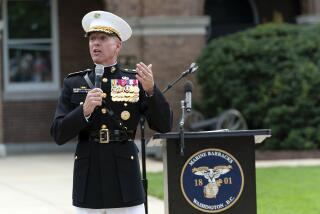Sub Captain to Lose Job but Not Freedom
- Share via
A top Navy admiral has decided against courts-martial in the Greeneville submarine disaster but will order the sub’s captain to an administrative hearing that will force his departure from the service, Navy sources said Wednesday.
In a decision that may be announced as soon as Friday, Adm. Thomas Fargo, commander of the Pacific Fleet, will conclude that the deadly collision between the submarine and a Japanese trawler was the result of unprofessional conduct by Cmdr. Scott Waddle and lead sonar analyst Petty Officer Patrick Seacrest. Fargo could announce his decision as soon as Friday.
Fargo will accept Waddle’s resignation during a hearing--known as an “admiral’s mast”--and Waddle will be granted an honorable discharge with a pension, according to sources close to the inquiry. An admiral’s mast is held to mete out punishment.
Nine crew members and students aboard the trawler Ehime Maru died when it was struck by the submarine Greeneville on Feb. 9 off Hawaii. The sub was executing a rapid ascent maneuver.
Four officers, including the chief of staff for the top admiral in the Pacific Fleet submarine service, will receive punitive letters or verbal reprimands, although those actions will not be career ending, sources said.
Fargo, a former submariner himself, has concluded that the 16 civilians aboard the Greeneville were not responsible for the collision. But he will recommend a review of the Navy’s Distinguished Visitors program and an end to captains using their boats to “show off” for civilians, which is what happened on the day of the crash.
As an enlisted sailor, Seacrest will be ordered to his own disciplinary hearing, known as a captain’s mast. Seacrest failed to notify Waddle and other officers that the Ehime Maru was moving rapidly toward the sub’s location.
The officer who convenes the disciplinary hearing for Seacrest also could order him to a “show-cause” board to explain why he should not be dismissed from the Navy, although it is considered unlikely that Seacrest will be sent to such a board given his spotless 14-year record, sources said.
Fargo, Waddle Plan to Visit Japan
Fargo and Waddle, who both grew up in Japan as sons of career military officers, know that the decision not to order courts-martial will be controversial in Japan.
Each plans his own trip to Japan; Fargo to explain his decision, Waddle to apologize to the families of those killed and to the Japanese public.
Charles Gittins, Waddle’s attorney, has said repeatedly that his client knows his Navy career is finished and is willing to leave the Navy voluntarily, as long as he is not charged with a criminal offense and not stripped of his pension.
Fargo will accept most, possibly all, of the findings and recommendations of a court of inquiry that heard 33 witnesses, including Waddle and Seacrest, over 12 days, sources said. Fargo received the court’s report Friday during a three-hour meeting with the three admirals who served on the panel.
In his decision, to be announced at the base at Pearl Harbor, Hawaii, Fargo will conclude that Waddle is ultimately responsible for all mistakes made by his subordinates and for fostering a “command climate” that made other officers afraid to confront him even when they felt he was doing things that were unsafe, sources said.
Waddle, the sources added, will be faulted for not demanding that a key piece of equipment be fixed, for not taking steps to keep unqualified personnel from working at sonar stations without proper supervision, and for making only a cursory, 80-second periscope check before ordering his submarine to execute a rapid ascent to impress the civilians.
Guided by Navy lawyers, Fargo has agreed with the admirals, and a Japanese admiral who acted as a nonvoting advisor, that a court-martial would not result in the discovery of any significant facts that were beyond the reach of the court of inquiry.
Navy legal experts note that a court of inquiry has far wider authority to search out facts than a court-martial, which is concerned with the narrow issue of guilt or innocence and limited to rules of evidence.
There also is a concern among Navy officials that, even if Waddle was charged with a criminal offense, such as dereliction of duty or negligence, a conviction would have been uncertain and led to what one Navy official calls the “nightmare” scenario: anger in Japan that Waddle was not convicted, anger in the United States that he was even put on trial and further tensions between the two countries.
Two Greeneville officers, Lt. Cmdr. Gerald Pfeifer and Lt. j.g. Michael Coen, will receive reprimands, sources said. Both remain on the Greeneville and are scheduled to be aboard when it deploys in several months under a new captain.
Pfeifer and Coen declined to intervene when they saw Waddle, in a rush to finish the daylong public relations cruise, cutting safety corners.
Fargo is expected to take similar action against Capt. Robert Brandhuber and Lt. Cmdr. Dave Werner, sources said. Werner, a public affairs officer, arranged the Feb. 9 cruise for visiting VIPs; Brandhuber, the submarine fleet chief of staff, was aboard the Greeneville but failed to intervene when he thought Waddle was ignoring safety rules.
From the beginning, Fargo has promised a complete and open investigation. But he is also known to be eager to finish the inquiry.
Wednesday, the Pacific Fleet submarine fleet will get a new commander under a change scheduled months before the collision. Fargo is eager to finish the Greeneville issue before Rear Adm. John B. Padgett III takes over from Rear Adm. Al Konetzni.
Fargo will recommend that the Navy’s Distinguished Visitors program be modified so that civilians are not allowed at the controls, that no ship is put to sea solely as a public relations program and that no skipper puts his ship through a risky maneuver such as a rapid ascent solely to provide a show for civilians.
Some of those changes have already been ordered on a temporary basis by the acting secretary of the Navy.
The only reason the Greeneville was at sea Feb. 9 was to accommodate 16 civilians, 13 of whom were active in fund-raising to build a memorial and museum for the battleship Missouri, where the Japanese signed the unconditional surrender that ended World War II.
The Distinguished Visitors program, Fargo has concluded, should be to help important “opinion-makers” in the civilian community better understand the Navy, not to reward confirmed Navy boosters.
During the VIP visit, Waddle took the boat to a speed and depth beyond what the Navy publicly admits are the submarine’s limits. The Navy will only admit that a modern submarine can go 34.5 miles per hour and to a depth of 800 feet.
In an admiral’s mast--or a captain’s mast for enlisted ranks--an individual service member is told that he is suspected of violating military law and asked to explain himself. An admiral--or captain--conducting a mast has unilateral power to order a reduction in rank, loss of pay and even a form of house arrest for a short period. Demeanor and candor are important factors in deciding punishment, officials said.
During the court of inquiry, Waddle took responsibility for the collision, although he also criticized his crew members for failing to do their jobs. Seacrest answered all questions directly and offered no excuses for his lapse, except that he got inexplicably lazy at a critical time.
An admiral’s mast can lead to someone being dismissed from the service, either voluntarily as part of an informal plea bargain or by being referred to a show-cause panel.
Broad Authority Over Inquiry
As commander of the Pacific Fleet, Fargo has virtually unlimited authority over the inquiry process and possible punishment. He ordered that the court of inquiry be convened and he selected the three admirals; even if he ordered a court-martial, any guilty judgment would return to Fargo for confirmation.
Fargo’s decision not to order courts-martial is squarely within Navy tradition.
There are few cases of ship commanders ordered to a court-martial for collisions at sea or other training accidents that result in loss of life. Loss of command and career is usually seen as a fitting punishment.
In 1992, for example, no courts-martial were ordered for an accident in which two missiles were fired at a Turkish destroyer, killing the Turkish captain and others. And in 1960, no criminal charges were brought for the fire in the New York Navy Yard that killed 50 people.
In keeping with Fargo’s desire to make the inquiry a public process, much of the court of inquiry’s 2,000-page report will be available on a Navy Web site as soon as Fargo’s decision is announced.
More to Read
Sign up for Essential California
The most important California stories and recommendations in your inbox every morning.
You may occasionally receive promotional content from the Los Angeles Times.













